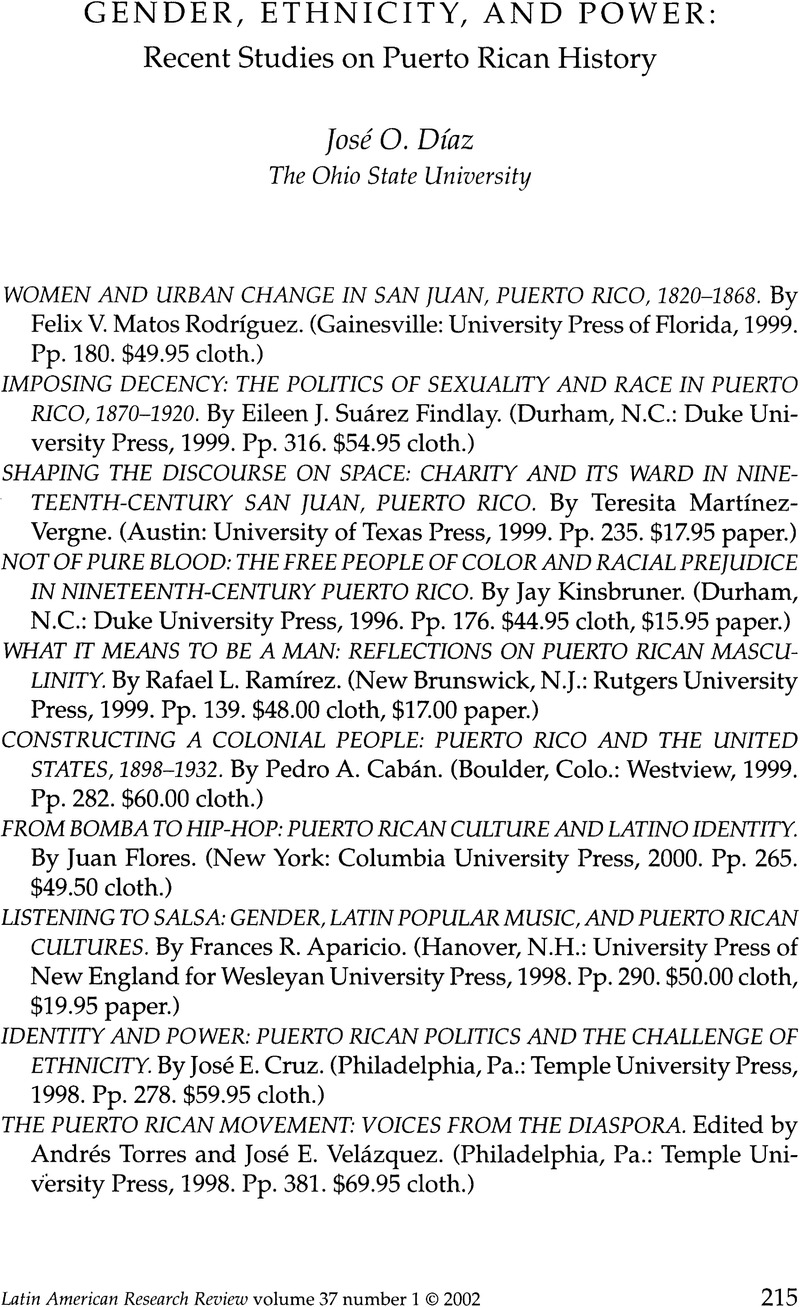Published online by Cambridge University Press: 05 October 2022

1. The island of Vieques, to the east of the big island of Puerto Rico, has a population of 9,400. Since 1938, the U.S. Navy has been acquiring land in Vieques through expropriation. The Navy now has de facto control of 26,000 of Vieques's 33,000 acres. Located at the eastern and western sections of the island, the U.S. Navy base uses three-quarters of the island's terrain for war maneuvers and bomb storage.
2. On 19 Apr. 1999, two F-18 airplanes dropped two five-hundred-pound bombs outside their target area and killed David Sanes, a Vieques civilian, and injured four others, including a soldier.
3. See Helen Safa, The Myth of the Male Breadwinner: Women and Industrialization in the Caribbean (Boulder, Colo.: Westview, 1995); Gontran Lamberty and Cynthia García Coll, Puerto Rican Women and Children: Issues in Health, Growth, and Development (New York: Plenum, 1994); Altagracia Ortiz, Puerto Rican Women and Work: Bridges in Transnational Labor (Philadelphia, Pa.: Temple University Press, 1996); Jean P. Peterman, Telling Their Stories: Puerto Rican Women and Abortion (Boulder, Colo.: Westview, 1996); Consuelo López-Springfield, Daughters of Caliban: Caribbean Women in the Twentieth Century (Bloomington: Indiana University Press, 1997); and Frances Negrón-Muntaner and Ramón Grosfoguel, Puerto Rican Jam: Essays on Culture and Politics (Minneapolis: University of Minnesota Press, 1997).
4. For works on countries outside the Caribbean region, see Susan K. Besse, Restructuring Patriarchy: The Modernization of Gender Inequality in Brazil, 1914–1940 (Chapel Hill: University of North Carolina Press, 1996); Donna J. Guy, Sex and Danger in Buenos Aires: Prostitution, Family, and Nation in Argentina (Lincoln: University of Nebraska Press, 1991); and Francesca Miller, Latin American Women and the Search for Social Justice (Hanover, N.H.: University Press of New England, 1991).
5. Teresita Martínez-Vergne, Central San Vicente in the Late Nineteenth Century (Gainesville: University of Florida Press, 1992).
6. See, for example, Joel Williamson, New People: Miscegenation and Mulattoes in the United States (Baton Rouge: Louisiana State University Press, 1995).
7. Richard Harding Davis, The Cuban and Porto Rican Campaigns (London: W. Heinemann, 1899).
8. Some changes were purely symbolic. Following the U.S. victory in the Spanish American War, the members of the Grand Army of the Republic (GAR), the organization of Civil War veterans of the Union Army, donated six hundred American flags for the schoolhouses of newly conquered Puerto Rico. See Stuart McConnell, Glorious Contentment: The Grand Army of the Republic, 1865–1890 (Chapel Hill: University of North Carolina Press, 1992), 233.
9. A cursory survey of the WorldCat database yielded seventy-five titles dealing with sexual harassment, sex education, sex education, and sex crimes in Puerto Rico. The same database produced only eight titles dealing with masculinity, most representing unpublished research (theses and dissertations).
10. The AIDS epidemic has seriously affected Puerto Rico and the Puerto Rican population in the United States. From 1981 through mid-April of 1994, almost thirteen thousand cases of AIDS were diagnosed in Puerto Rico, 58 percent of whom have died, according to the Programa de Vigilancia de SIDA. By 1991, AIDS had become the fourth-largest cause of general mortality, the largest cause of death for men between the ages of twenty-five and forty-nine, and the largest cause for women between the ages of twenty and thirty-nine. These deaths represented 31.6 percent of all deaths of men and 27.2 percent of all deaths of women in these categories according to the Oficina de Estadísticas de Salud. The figures are similar to those for Puerto Ricans living in the United States. According to the Center for Disease Control and Prevention, in 1990 AIDS accounted for approximately 40 percent of all deaths among men and some 30 per cent of deaths among women of Puerto Rican origin in the United States between the ages of twenty-five and forty-four.
11. Juan Flores, Divided Borders: Essays on Puerto Rican Identity (Houston, Tex.: Arte Público Press, 1993).
12. Ruth Glasser, My Music Is My Flag: Puerto Rican Musicians and Their New York Communities, 1917–1940 (Berkeley and Los Angeles: University of California Press, 1995); and Paul Austerliz, Merengue: Dominican Music and Dominican Identity (Philadelphia, Pa.: Temple University Press, 1997). Other important works include Peter Manuel, Caribbean Currents: Caribbean Music from Rumba to Reggae (Philadelphia, Pa.: Temple University Press, 1995); Sue Steward, Música—Salsa, Rumba, Merengue, and More: The Rhythm of Latin America (San Francisco, Calif.: Chronicle Books, 1999); and Vernon Boggs, Salsiology: Afro-Cuban Music and the Evolution of Salsa in New York City (New York: Excelsior Music, 1992).
13. José Cabranes, Citizenship and the American Empire: Notes on the Legislative History of the U.S. Citizenship of Puerto Ricans (New Haven, Conn.: Yale University Press, 1979), 14.